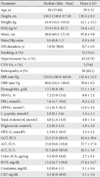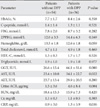1. Wild S, Roglic G, Green A, Sicree R, King H. Global prevalence of diabetes: estimates for the year 2000 and projections for 2030. Diabetes Care. 2004. 27:1047–1053.
2. Carrington AL, Shaw JE, Van Schie CH, Abbott CA, Vileikyte L, Boulton AJ. Can motor nerve conduction velocity predict foot problems in diabetic subjects over a 6-year outcome period? Diabetes Care. 2002. 25:2010–2015.
3. Vinik AI, Park TS, Stansberry KB, Pittenger GL. Diabetic neuropathies. Diabetologia. 2000. 43:957–973.
4. Kim BW, Kim DH, Kim JG. Comparisons between several neurologic tests of large myelinated nerves in type 2 diabetic patients with peripheral polyneuropathy. J Korean Diabetes Assoc. 1999. 23:562–574.
5. Feldman EL, Stevens MJ, Thomas PK, Brown MB, Canal N, Greene DA. A practical two-step quantitative clinical and electrophysiological assessment for the diagnosis and staging of diabetic neuropathy. Diabetes Care. 1994. 17:1281–1289.
6. van Deursen RW, Sanchez MM, Derr JA, Becker MB, Ulbrecht JS, Cavanagh PR. Vibration perception threshold testing in patients with diabetic neuropathy: ceiling effects and reliability. Diabet Med. 2001. 18:469–475.
7. Mueller MJ. Identifying patients with diabetes mellitus who are at risk for lower-extremity complications: use of Semmes-Weinstein monofilaments. Phys Ther. 1996. 76:68–71.
8. Ferreira MC, Rodrigues L, Fels K. New method for evaluation of cutaneous sensibility in diabetic feet: preliminary report. Rev Hosp Clin Fac Med Sao Paulo. 2004. 59:286–290.
9. Hopps E, Noto D, Caimi G, Averna MR. A novel component of the metabolic syndrome: the oxidative stress. Nutr Metab Cardiovasc Dis. 2010. 20:72–77.
10. Lim JS, Yang JH, Chun BY, Kam S, Jacobs DR Jr, Lee DH. Is serum gamma-glutamyltransferase inversely associated with serum antioxidants as a marker of oxidative stress? Free Radic Biol Med. 2004. 37:1018–1023.
11. Jung YS, Lee KY, Lee SK, Kim HK, Park HY, Kang MH. Peripheral polyneruopathy and hypoinsulinemia in patients with type 2 diabetes. J Korean Diabetes Assoc. 2000. 24:256–266.
12. Herder C, Lankisch M, Ziegler D, Rathmann W, Koenig W, Illig T, Doring A, Thorand B, Holle R, Giani G, Martin S, Meisinger C. Subclinical inflammation and diabetic polyneuropathy: MONICA/KORA Survey F3 (Augsburg, Germany). Diabetes Care. 2009. 32:680–682.
13. Gross JL, de Azevedo MJ, Silveiro SP, Canani LH, Caramori ML, Zelmanovitz T. Diabetic nephropathy: diagnosis, prevention, and treatment. Diabetes Care. 2005. 28:164–176.
14. Cabezas-Cerrato J. Neuropathy Spanish Study Group of the Spanish Diabetes Society (SDS). The prevalence of clinical diabetic polyneuropathy in Spain: a study in primary care and hospital clinic groups. Diabetologia. 1998. 41:1263–1269.
15. Boulton AJ, Malik RA, Arezzo JC, Sosenko JM. Diabetic somatic neuropathies. Diabetes Care. 2004. 27:1458–1486.
16. Figueroa-Romero C, Sadidi M, Feldman EL. Mechanisms of disease: the oxidative stress theory of diabetic neuropathy. Rev Endocr Metab Disord. 2008. 9:301–314.
17. Edwards JL, Vincent AM, Cheng HT, Feldman EL. Diabetic neuropathy: mechanisms to management. Pharmacol Ther. 2008. 120:1–34.
18. Zotova EV, Chistiakov DA, Savost'ianov KV, Bursa TR, Galeev IV, Strokov IA, Nosikov VV. Association of the SOD2 Ala(-9) Val and SOD3 Arg213Gly polymorphisms with diabetic polyneuropathy in patients with diabetes mellitus type 1. Mol Biol (Mosk). 2003. 37:404–408.
19. Ziegler D, Ametov A, Barinov A, Dyck PJ, Gurieva I, Low PA, Munzel U, Yakhno N, Raz I, Novosadova M, Maus J, Samigullin R. Oral treatment with alpha-lipoic acid improves symptomatic diabetic polyneuropathy: the SYDNEY 2 trial. Diabetes Care. 2006. 29:2365–2370.
20. Cameron NE, Cotter MA, Horrobin DH, Tritschler HJ. Effects of alpha-lipoic acid on neurovascular function in diabetic rats: interaction with essential fatty acids. Diabetologia. 1998. 41:390–399.
21. Lee DH, Gross MD, Jacobs DR Jr. Association of serum carotenoids and tocopherols with gamma-glutamyltransferase: the Cardiovascular Risk Development in Young Adults (CARDIA) Study. Clin Chem. 2004. 50:582–588.
22. Drozdz R, Parmentier C, Hachad H, Leroy P, Siest G, Wellman M. gamma-Glutamyltransferase dependent generation of reactive oxygen species from a glutathione/transferrin system. Free Radic Biol Med. 1998. 25:786–792.
23. Takigawa T, Hibino Y, Kimura S, Yamauchi H, Wang B, Wang D, Ogino K. Association between serum gamma-glutamyltransferase and oxidative stress related factors. Hepatogastroenterology. 2008. 55:50–53.
24. Bonnefont-Rousselot D, Beaudeux JL, Therond P, Peynet J, Legrand A, Delattre J. Diabetes mellitus, oxidative stress and advanced glycation endproducts. Ann Pharm Fr. 2004. 62:147–157.
25. Aikawa M, Sugiyama S, Hill CC, Voglic SJ, Rabkin E, Fukumoto Y, Schoen FJ, Witztum JL, Libby P. Lipid lowering reduces oxidative stress and endothelial cell activation in rabbit atheroma. Circulation. 2002. 106:1390–1396.
26. Demircan N, Gurel A, Armutcu F, Unalacak M, Aktunc E, Atmaca H. The evaluation of serum cystatin C, malondialdehyde, and total antioxidant status in patients with metabolic syndrome. Med Sci Monit. 2008. 14:CR97–CR101.
27. Lim JS, Kim YJ, Chun BY, Yang JH, Lee DH, Kam S. The association between serum GGT level within normal range and risk factors of cardiovascular diseases. J Prev Med Public Health. 2005. 38:101–106.
28. Koh JH, Lee MY, Nam SM, Sung JK, Jung PM, Noh JK, Shin JY, Shin YG, Chung CH. Relationship between menopausal status and metabolic syndrome components in Korean women. Korean Diabetes J. 2008. 32:243–251.
29. Elliott J, Tesfaye S, Chaturvedi N, Gandhi RA, Stevens LK, Emery C, Fuller JH. Large-fiber dysfunction in diabetic peripheral neuropathy is predicted by cardiovascular risk factors. Diabetes Care. 2009. 32:1896–1900.
30. Jurado J, Ybarra J, Romeo JH, Pou JM. Clinical screening and diagnosis of diabetic polyneuropathy: the North Catalonia Diabetes Study. Eur J Clin Invest. 2009. 39:183–189.
31. Jin HY, Jeung SJ, Kim CH, Park JH, Baek HS, Park TS. Erythropoietin levels according to the presence of peripheral neuropathy in diabetic patients with anemia. J Korean Diabetes Assoc. 2007. 31:151–156.
32. Jeong IK, Park KS, Moon MK, Kim JH, Shin CS, Kim SY, Lee HK. The association of aldose reductase gene polymorphisms with neuropathy in patients with type 2 diabetes. J Korean Diabetes Assoc. 2007. 31:274–283.
33. Ha SW, Lee HJ, Han JH, Jung SW, Nam JH, Sin BH, Koo SM, Kim JG, Kwon S, Kim BW. Relationship between peripheral neuropathy and cardiovascular autonomic neuropathy in non-insulin dependent diabetics. J Korean Diabetes Assoc. 1997. 21:476–483.








 PDF
PDF ePub
ePub Citation
Citation Print
Print



 XML Download
XML Download